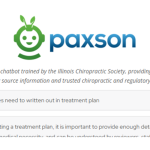
Don’t Be in Documentation Denial

Many of the doctors we meet tell us they’re not too worried about their documentation. “We think we’re probably fine,” they say. After all, they’ve just listened to an eight-hour training on documentation, heard the stories of issues brought by insurance carriers but have decided to step back into their practices and take their chances.
We wish we shared their optimism; however, statistics, coupled with practical experience, tell us their documentation is most likely not as “fine” as they would hope. In recent years, the HHS Office of Inspector General (OIG) reported that as many as 94% of chiropractic records are missing, or inadequately reflect, some key elements — evaluation, a treatment plan, medical necessity, and/or contraindications to treatment. That statistic matches up with what we generally find when looking at someone’s documentation as a sort of “white hat” auditor. Even DCs who tell us at the outset that they think their paperwork is solid have documentation errors that put their practice at risk.
100% Documentation Error Rate
A great example is a recent new client who was more open-minded to a “white hat” audit. This DC came to us because of documentation concerns. She was horrified when we found that her Medicare documentation error rate was 100%! How could that be possible?! This error rate tells us there was something seriously missing, miscoded, or misstated in every single Medicare claim the practice filed. Their risk factor for an audit? Extremely high.
These are the kinds of errors our “white hat audits” most commonly find:
- Miscoding E/M services
The Centers for Medicare and Medicaid Services (CMS) have set forth clear guidelines for what’s required for documentation and coding of these services. But because many doctors have never seen these guidelines, they tend to use whatever code feels right, or rely on the amount of time spent. That means some doctors will end up “guessing” too high or too low for work performed. Conducting a review of information and creating a checklist of the items required reveals surprising amounts of work being done and not billed, or it is possible to find that what is being documented is incomplete. Either way, both under- or over-coding constitute waving a red flag. Auditors examine outliers—any doctor who falls outside normal billing patterns—more closely.
- Coding and documenting incorrectly
Doctors know the treatment they give an individual patient and therefore feel justified in how they code the service—but if documentation doesn’t support the code, there is definitely a problem. Remember, as far as a third-party payer (or auditor) is concerned, if it isn’t in writing, it didn’t happen. So, if, for example, you bill a chiropractic manipulative treatment (CMT) code for a certain level of service, but the documentation only justifies a lesser number of regions treated, you’ve just waved another red flag. Note: these kinds of mistakes are most often found in post-payment audit reviews and can cost a practice thousands of dollars in repayment. This should be a reminder to ensure that daily documentation records and billing records match exactly.
- Cloning records or rote justification of medical necessity
When each chiropractic visit looks the same as the last and statements like “same as last visit” pepper the daily notes, it’s difficult for a third-party reader to ascertain the necessity of each visit. Standard guidelines dictate what must be included, and it can be very easy to get into the trap of rushing through your daily documentation. Most documentation software programs start with the notes from the last visit, so you can modify from there. The mistake here is when you get rushed or lax and are tempted to minimally modify and move on. Resist the impulse, and make sure each visit and its documentation is “encounter-specific.”
These aren’t the only mistakes we find, by a long shot—others include easy-to-overlook mistakes like a doctor’s initials instead of a full signature or general illegibility in the notes. Any of them can kick back a claim or can be a problem in an audit.
Fortunately, as with most things, being willing to admit there is a problem is a huge step in the right direction. Our client with the 100% error rate? Thanks to a lot of unflinching courage and a little hard work, the practice’s Medicare claim error rate is currently 8%. Now, that’s a number that justifiably inspires confidence.
So, for those reading who still think, “Yeah, that must have been one messed up practice; our documentation is fine”—well, you may be right. But statistics say that you have a 94% chance of being wrong. How do you like your odds?
Kathy Mills Chang is a Certified Medical Compliance Specialist (MCS-P). Certified Chiropractic Professional Coder (CCPC), and Certified Clinical Chiropractic Assistant (CCCA). Since 1983, she has been providing chiropractors with reimbursement and compliance training, advice, and tools to improve the financial performance of their practices. Kathy leads a team of 30 at KMC University and is known as one of our profession’s foremost experts on Medicare, documentation and CA development.
Brandy Brimhall CPC, CPCO, CMCO, CCCPC, CPMA has been an advocate to chiropractic practices since 1999. She has excelled in the areas of billing, coding, collections, compliance and practice administration. She has obtained multiple certifications to further enhance her skill set to assist practices. Brandy has also presented from multiple public platforms to train doctors and CAs on these areas of practice. She currently serves as a Subject Matter Expert for KMC University.
Kathy or any of her team members can be reached at (855) 832-6562 or info@KMCUniversity.com

















